The Acropolis of Athens Old Museum
IntroductionThe Museum existing until lately on the Acropolis rock was considered among the most important ones in the world and definitely the most important one as far as the History of European Art is concerned. It was built on the Acropolis Hill in 1874, in such a way that it would not aesthetically interfere with the Temples, nor be visible from anywhere within the city of Athens.
The excavations that followed, toward the end of the 19th century, unearthed a wealth of finds which were impossible to exhibit in the limited space of the Museum. Thus, the inscriptions, bronzes, clay objects, and a variety of other items were kept in the National Archaeological Museum, where they were originally taken for conservation. The situation was aggravated after all the marble pieces were removed from the Parthenon Friezes (that is, what was left over after Elgin's plunder) and were put in the museum, together with the Caryatids (the marble statues of the women supporting the roof of the south porch of the Erechtheion), all of which were removed to be kept in an air-tight window containing nitrogen, so as to stop air pollution from deteriorating the marble surfaces.
The collections of the museum included:
Sculptural offerings of the Archaic period
Pediments of temples dated to the Archaic period
Archaic Horsemen
Sculptures of the "Severe" style
Pediments and metopes from the Parthenon
The Parthenon frieze
The Erechtheion frieze
Parapets of the Athena Nike temple
Frieze of the Athena Nike temple
The Caryatids
Clay figurines and vases from the sanctuary of the Nymphs.
Everyone was eagerly anticipating the completion of the new Acropolis Museum, for the total wealth of finds related to the Acropolis and the Parthenon to finally be exhibited in the best possible way (combining location, lighting, space, air filtering and thematic consistency), and thus deprive the descendants of Lord Elgin of all plausible excuses to insist that the Parthenon Marbles continue to be kept separated from the rest of their like and the Parthenon remain in its mutilated state.
During 2008, the exhibits of this Museun were transferred to the New Museum, the erection of which was completed. Three huge cranes were used to carry all the heavy marble statues and exhibits, a total of some 4,500 artifacts from the old, cramped Acropolis museum, a task that was the biggest airlift of antiquities in Greek history. It was the first time the artifacts — some of which are considered among the most important works of antiquity — were moved from the very Acropolis Rock. This transfer was completed in the end of spring but putting up the exhibits in their right place would take a lot longer.
We thought that the present Album would become useless after the New Museum's inauguration. Nevertheless, the decision of the museum authorities to prohibit taking photographs of the exhibits in their new surrounding created more problems than the ones it was supposed to solve. We admit that the decision was well meant, but, with all due respect, we would like to point out that times have changed; we are afraid that whatever is not shown online cannot achieve the level of promotion that it may be worthy of. We managed, though, to get a number of photos of the exhibits, as the decision was taken a couple of weeks after the museum's inauguration. We are working on them and will do our best to put them up as soon as possible. But, in our effort to best present the exhibits, we are sorry to have to use some of the photos taken at the Old Acropolis Museum. Until the New Acropolis Museum album is online, please enjoy the marvellous artifacts at their old "home".
(Photos: Michael Tziotis)
Select Page of the Album:
Click on any of the pictures to enlarge.
Gallery ISculptures from the decoration of early Archaic buildings (600 - 570 BC). The Hydra Pediment, pediment with a lioness tearing apart a calf and Gorgo.
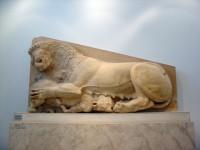
Akr 4. Lioness Hunt
A lioness having just attacked and killed a calf adorned the right half of a poros limestone pediment of a large archaic temple, probably from the earliest Parthenon. Another similar complex would have been symmetrically decorating the left wing of the pediment. Details like the eyes of both beasts, the mane of the lioness and more, are emphasized by incising and painting with intense-colored paints, traces of which are still visible. Dated to around 570 B.C. |
|
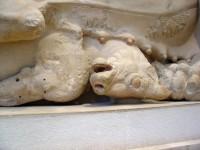
Akr 4. Lioness Hunt (Detail) |
|
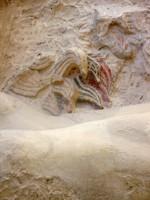
Akr 4. Lioness Hunt (Mane Detail with Coloring) |
|
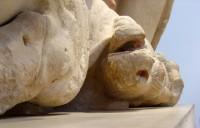
Akr 4. Lioness Hunt (Detail of the Calf's Head under the Lion's Weight) |
|
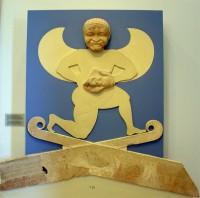
Akr 701-Akr 3798. The Gorgon
The mythical winged monster decapitated by Perseus, comes from an early archaic temple, probably the earliest Parthenon. The marble figure, of which only the head and a portion of the waist with a snake belt are preserved, has been restored as the central “acroterion” of the building. However, this reconstruction is not absolutely certain. About 570 B.C. |
|
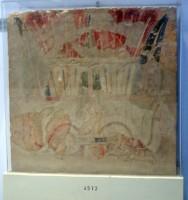
Akr 4572. Lotus Flower
Eaves block of poros limestone from a large archaic temple, probably the earliest Parthenon. The block is decorated with an elaborately incised lotus flower palmette, brilliantly colored. About 570B.C. |
|

Akr 1. The Hydra Pediment
Please scroll the photo to see the whole of it. |
|
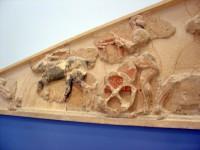
Akr 1. The Hydra Labor Pediment (Left Half)
Half of an archaic pediment representing one of Hercules’ Labors, the killing of the monster Lernaea Hydra. In this photographed portion, Iolaos, Hercules’ nephew and helper, is about to ride a chariot drawn by two horses. At the right side of the photo, Hercules’ foot is visible, as well as his right elbow, while he is fighting against the monster, which he has grasped by one of its necks with his left hand, not visible in the photo. The crab at the far left corner is the Hydra’s ally. This pediment is dated to about 580 B.C. |
|
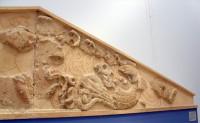
Akr 1. The Hydra Labor Pediment (Right Half)
The Hydra pediment must have belonged to a small building on the Acropolis that has not survived. The low relief, carved in soft poros limestone was brightly colored. It depicts the famous Labor of Heracles against the Lernaean Hydra. In the center of the composition, the hero pounds his club against the monster, spread across the whole right wing of the pediment. |
|
|
Select Page of the Album:
|
|



